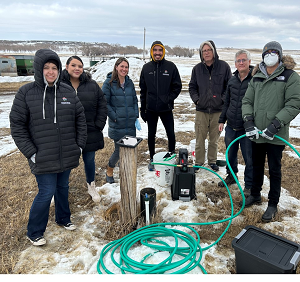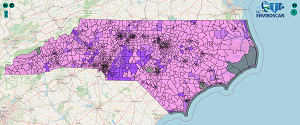Features
Work with Communities in Rural and Under-Resourced Areas
Scientists funded by the NIEHS Superfund Research Program (SRP) are partnering with communities in rural areas to identify health risks and develop remediation methods for contaminants. They use participatory research to sample air, water, and soil, and share findings aiming to improve people's well-being.
Safer Water for Rural Areas

Columbia SRP researchers work with an indigenous-owned research organization, Missouri Breaks, to sample wells for arsenic contamination. From left to right: Rebecca White Bull, Sandy Little, Rae O'Leary, Randall Hughes, James Ross, Steven Chillirud, and Anibran Basu. (Photo courtesy of Columbia SRP)
Researchers at the Columbia University SRP Center found that communities in the Northern Great Plains were among those more likely to be impacted by increased arsenic levels in their drinking water. So, Columbia SRP scientists launched a community-led intervention project to reduce arsenic in drinking water. They tested wells for contaminants, installed arsenic filtration systems under kitchen sinks, and informed communities about arsenic-reduction strategies. The team found that these interventions successfully reduced arsenic exposure among program participants.
At the University of California (UC), Berkeley SRP Center, scientists are conducting research in Central Valley, California, an agricultural region that is home to one third of domestic well users in the state. Because many wells and other drinking water sources contain metals like arsenic and other contaminants, UC Berkeley researchers collaborated with the Community Water Center to develop the Drinking Water Tool, an interactive web portal that provides information on water quality and management based on location. The tool is available in English and Spanish. In 2023, UC Berkeley researchers used the Drinking Water Tool to characterize disparities in exposures in Central Valley and found that 48% of well users are low-income and 89% are likely to have water with manganese levels above the health advisory limit.

NC ENVIROSCAN shows mean arsenic levels in census tracts across the state. Darker colors indicate increased levels of arsenic. (Photo courtesy of NC ENVIROSCAN)
North Carolina has some of the highest numbers of private well users in the country, which are unregulated by health departments and are often contaminated with arsenic and other metals. The University of North Carolina at Chapel Hill (UNC) SRP Center is developing creative strategies to test the water of well users in rural areas, such as sending well tests directly to homes, with explicit and easy-to-understand directions and a pre-paid label to mail their samples back to UNC. They are also conducting outreach to reduce exposures, such as through educational campaigns and by providing filter pitchers to residents with high levels of contaminants in their water.
Sustainable Clean Up Strategies
Low-cost, sustainable strategies to remove contaminants from the environment are essential for rural communities. SRP-funded researchers are using nanomaterials, plants, fungi, and bacteria to develop cost-effective solutions to protect communities from environmental hazards. To learn more about some of this work see the following resources:
- June 2022 Science Digest: Bioremediation
- This edition’s Technology Profile featuring a banana peel-based water treatment technology
The UNC SRP team also developed several tools and approaches to inform decision-making:
- NC ENVIROSCAN is a website that allows users to visualize trends across contaminants, sociodemographic characteristics, environmental health disparities indicators, and health outcomes. Community members, government agencies, and clinicians can use NC ENVIROSCAN to identify contaminants of concern and learn about other local health risks and potential solutions.
- The Chemical and Social Stressors Integration Technique can identify distinct at-risk geographic areas based on environmental chemical exposure and social vulnerability.
- The Toxic Metal Environmental Justice Indices help decision-makers prioritize geographic areas for intervention or remediation by comparing the percentage of a region’s population with water samples exceeding national standards for contaminants.
Also in North Carolina, scientists and community engagement experts at the North Carolina State University SRP Center are using outreach strategies to help rural communities near the Cape Fear River basin understand PFAS exposure in drinking water. The team led a study analyzing blood samples for GenX and other PFAS compounds. Preliminary findings showed PFAS levels above the national average in almost all participants’ blood samples. Researchers worked quickly to report their findings back to communities by hosting a community meeting and sending out 11-page letters with customized results to participants.
In collaboration with Tribal researchers and community members, Massachusetts Institute of Technology (MIT) SRP researchers are assessing a rural Maine Tribal community’s exposure to drinking water contaminants. Scientists partnered with the Sipayik Environmental Department to build a study investigating drinking water quality. Using a participatory science model, the team recruited participants from the community; community members submitted household water samples; and then the team analyzed those samples and shared the data with communities. Researchers reported successful engagement, with 29% of households in the region participating.
Health-Protective Interventions and Outreach in Rural Communities

Richmond-Bryant, right, and a member of her research team, Chuqi Guo, Ph.D., left, set up measurement devices in Colfax. (Image courtesy of Jennifer Richmond-Bryant)
Scientists from the Louisiana State University (LSU) SRP Center are documenting exposures and health impacts that may be linked to pollution from a waste treatment plant in Colfax, a small town in Louisiana. Led by Jennifer Richmond-Bryant, Ph.D., a team of researchers collected oral histories by interviewing Colfax residents about their health experiences after the treatment plant increased operations in the community. The researchers also analyzed air samples from around Colfax to map the spread of contaminants from the thermal plant. They combined these maps with the oral histories and found that the types of chemicals released and the spread of pollution aligned with the health issues that residents reported.
The University of Kentucky SRP Center is working with communities in Eastern Kentucky to promote nutritional interventions that can help protect against the harmful effects of environmental toxins. The team found that simple diet changes, such as eating more blackberries and fish, can reduce cell damage from contaminants like PCBs. To educate community members about the benefits of certain foods, the center organized events to provide nutrition advice for people in these remote areas. Furthermore, UK SRP Center researchers worked with community partners to provide blackberries to residents of a rural senior center, ensuring that community members have access to health-protective foods.
Also in Kentucky, researchers at the University of Louisville SRP Center are working to understand how social and economic factors lead to differences in exposures to volatile organic compounds (VOCs) in urban and rural communities. For example, their recent study demonstrated that sex was associated with increased VOC exposure and liver injury. Louisville SRP Center scientists are also investigating how green spaces can reduce air pollution exposure, improve mental health and overall well-being, and lower disease risk.

A PROTECT participant brings her baby in for an assessment. The researchers chart babies’ birth outcomes and overall health. (Photo courtesy of PROTECT)
The Northeastern University SRP Center is studying the effects of contaminants on pregnancy outcomes in rural areas of Puerto Rico. Center researchers have found significant associations between maternal exposure to metals – such as manganese, copper, or nickel – and preterm birth, particularly in women with higher perceived stress, depression, lower socioeconomic status, and lower social support. To report back to the populations they are studying, the team created an app called “Mi PROTECT” to communicate environmental exposure results to study participants.
Responding to Environmental Disasters

Map indicating the location of the East Palestine train derailment. (Photo courtesy of NIEHS)
After a 2023 train derailment in East Palestine, a small town of approximately 5,000 residents in Ohio, researchers from the Texas A&M University, Wayne State University, and University of Kentucky (UK) SRP centers quickly mobilized to address community concerns. Texas A&M scientists used a mobile laboratory to monitor air contaminant levels, and Wayne State researchers measured contaminants in wells, surface water, and soil.
To learn more about other SRP-funded projects relevant to communities in rural areas, see the following Science Digest issues:
The UK team surveyed community residents for adverse symptoms and stress, and they worked with Wayne State scientists to test blood and urine samples for markers of inflammations. In collaboration with the Duke SRP Center, UK researchers also deployed silicone wristbands, invented by the Oregon State University SRP Center, to measure participants’ exposure to polycyclic aromatic hydrocarbons.
Funded by an SRP time-sensitive research grant, a team at the University of Arizona is studying how wildfires and flash flood events in rural areas of Arizona mobilize contaminants from abandoned mines, exposing nearby residents to toxic substances. The researchers are conducting surveys to understand individual- and community-level vulnerabilities, measuring contaminants, and working with community members to develop exposure prevention strategies.
to Top



